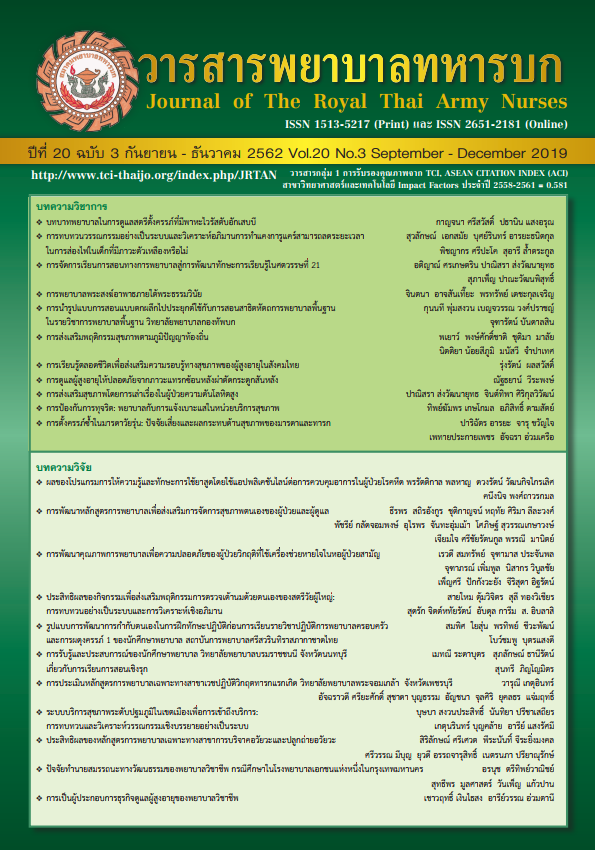Development of an Occupational Health and Safety Literacy Scale among Industrial Workers
Keywords:
Scale Development, Occupational Health and Safety Literacy, Industrial WorkersAbstract
This study aimed to develop an occupational health and safety literacy scale among industrial workers. Samples included 378 industrial workers. The developed scale consisted of 4 dimensions; accessing, understanding, appraising, and applying information. Confirmatory factor analysis and Cronbach’s alpha coefficients were used for testing construct validity and reliability of the scale. For its psychometric evaluation, confirmatory factor analysis showed that the model had satisfactory goodness of fit (GFI = 0.94, AGFI = 0.91, CFI = 0.98, NFI = 0.93) Cronbach’s alpha coefficients of the scale was 0.82. The results provide support for validity and reliability of the scale. This scale could be used to study in promoting an occupational health and safety literacy among industrial workers.
Downloads
References
2. Social Security Office. Occupational diseases and injuries situation: year 2013-2017. Nonthaburi: Social Security Office; 2019. (in Thai)
3. Social Security Office. Occupational diseases and injuries situation: year 2016. Nonthaburi: Social Security Office; 2016. (in Thai)
4. World Health Organization. 9th global conference on health promotion, Shanghai 2016. Geneva: World Health Organization. (in Thai)
5. Strategy and Planning Division. National strategic plan for 20 years. Nonthaburi: Ministry of Public Health; 2018. (in Thai)
6. Tachavijitjaru C. Health literacy: a key indicator towards good health behavior and health outcomes. Journal of The Royal Thai Army Nurses. 2018;19(Supplement):1-11. (in Thai)
7. Nutbeam D. The evolving concept of health literacy. Social Science & Medicine. 2008; 67:2072-2078.
8. Sorensen K, Broucke SV, Fullam J, Doyle G, Pelikan J, Slonska Z, Brand H. Health literacy and public health: a systematic review and integration of definitions and models. BMC Public Health. 2012;12(80):1-13.
9. Chahardah-Cherik Sh, Gheibizadeh M, Jahani S, Cheraghian B. The relationship between health literacy and health promoting behaviors in patients with type 2 diabetes. International Journal of Community Based Nursing and Midwifery. 2018;6(1):65-75.
10. Rauscher KJ, Myers D. Occupational health literacy and work-related injury among US adolescents. International Journal of Injury Control and Safety Promotion. 2014;21(1):81-89.
11. Yusida H, Suwandi T, Yusuf A, Sholihah Q. Relationship individual factors with occupational health literacy: observational study on industrial workers of sasirangan in south kalimantan. International Journal of Scientific and Research Publications. 2016;6(1):481-484.
12. DeVellis RF. Scale development: theory and applications (2nd ed.). London: Sage; 2003.
13. Tantranont K, Suthakorn W, Wisutthananon A. Measurement development on influencing factors of hearing protection use among industrial workers. Nursing Journal, 2013;40:73-83. (in Thai)
14. Health Education Division. Methods to promote and assess health literacy and health behaviors. Nonthaburi: Ministry of Public Health; 2018. (in Thai)
15. Lynn MR. Determination and quantification of content validity. Nursing Research. 1986;35(6):382-385.
16. Polit DF, Beck CT. The content validity index: are you sure you know what’s being reported? critique and recommendations. Research in Nursing & Health. 2006;29:489-497.
17. Polit DF, Hungler BP. Nursing research: principles and methods (6th ed.). Philadelphia: Lippincott; 1999.
18. Waltz CF, Strickland OL, Lenz ER. Measurement in nursing and health research (3rd ed.).New York: Springer; 2005.
19. Punpukdee A. The comparison of the use of statistics analysis in testing construct validity of social capital: an exploratory factor analysis (EFA) and a confirmatory factor analysis (CFA). Phitsanulok: Naresuan University; 2019.
20. Burns N, Grove SK. The practice of nursing research: conduct, critique, and utilization (5thed.). Missouri: Elsevier Saunders; 2005.
Downloads
Published
How to Cite
Issue
Section
License
บทความหรือข้อคิดเห็นใดใดที่ปรากฏในวารสารพยาบาลทหารบกเป็นวรรณกรรมของผู้เขียน ซึ่งบรรณาธิการหรือสมาคมพยาบาลทหารบก ไม่จำเป็นต้องเห็นด้วย
บทความที่ได้รับการตีพิมพ์เป็นลิขสิทธิ์ของวารสารพยาบาลทหารบก
The ideas and opinions expressed in the Journal of The Royal Thai Army Nurses are those of the authors and not necessarily those
of the editor or Royal Thai Army Nurses Association.






